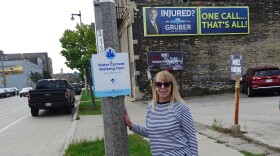Currently, Milwaukee's inner harbor is not an inviting space. But change is brewing.
UW-Milwaukee’s School of Freshwater Sciences completed a multi-million dollar expansion at the end of Greenfield Avenue. And last week, the EPA announced a $200,000 grant to improve 66 acres of the harbor near the school.
Still, stand outside the gleaming new addition to the School of Freshwater Sciences and do a 180. It’s not a pretty sight.
Ben Gramling works at the nearby Sixteenth Street Community Health Center. “You look directly across the street, you have the coal pile site,” he says.
The piles lay behind industrial fencing topped with barbed wire.

If you head west, pass under the railroad trestle and reach 1st St. and Greenfield Ave., you see raw earth waiting to become Freshwater Plaza.
Gramling helped found a non-profit called Harbor District, Inc., which aims to jumpstart revitalization here. He sees its future through the lens of the families the 16th Street health center serves. They live closest to the harbor.
“Those families need jobs, they need economic opportunity, but they also need an urban environment that’s going to support a healthy lifestyle and a high quality of life,” he says.
Gramling says staffers at 16th Street are already reaching out to neighbors. “We’ve been working for the last three or four months to set up one- on- one stakeholder interviews with folks,” he says.
Iris Gonzalez has been talking to neighbors. She’s a community engagement specialist at 16th Street.
“There’s really not a sense of space here – there’s not access to this place so it doesn’t me something as a space to them. And they’re also really concerned about how is this going to impact me, my neighborhood, my block,” Gonzalez says.
There’s no one more excited about the possibility of blending neighborhood and commerce here than Jim Wasley. “It’s loaded with potential – it just takes a little bit of vision making it a little less scary,” he says.
Wasley has asked his architecture students at UWM for their vision. Over the last three-plus years, they’ve penciled design upon design – blending commercial enterprises and housing, interspersed with walkways and public spaces.
Wasley hopes the renderings inspire what the harbor district can become.
“Reconnecting it to the city and then capitalizing on the fact that it’s waterfront land; ecologically it has a lot of potential to be a wonderful place to be and also to help the health of the harbor,” he says.
The EPA has long deemed the Milwaukee Estuary – the harbor and areas upstream polluted. The grant the agency has awarded the district - targeting 66 of its 1,000 acres – should help.

So will UWM’s School of Freshwater Sciences, according to Eric Leaf. He’s the school’s director of development.
Leaf says the school will design solutions that blend remediation of the land along with the health of the waters around it.
“So cleaning up some of the contaminants in the harbor, but even beyond that we’re exploring with the Wisconsin DNR, can we reestablish a sport fishery here in the harbor, not only in the inner harbor, but the outer harbor, specifically focused on fishes like yellow perch, large and small mouth bass, northern pike,” Leaf says.
Balancing fish and families is just part of Dave Misky’s vision for the harbor. He oversees the Redevelopment Authority of the City of Milwaukee.
Misky knows that the port remains an important economic engine – it connects goods that arrive by barge, truck and rail. Then there’s Jones Island – it is home to the sewerage treatment plan nearby.
Misky says this is the time for all stakeholders to think out of the box.
“Certainly this plan is not going to showcase converting Jones Island into condo development but it could be there are more efficient ways to operate some of the things going on in the harbor district,” Misky says.
Advocates for the harbor’s revitalization hope Milwaukee puts its emerging innovation know-how to work in its own backyard.







